How To Grow Saffron: A Comprehensive Guide from Planting to Harvest
- February 16, 2024
- 0 comment
Saffron, known scientifically as Crocus sativus, is a highly valued spice derived from the flower of the saffron crocus. It is renowned for its distinct flavor, color, and medicinal properties. Cultivating saffron can be a rewarding endeavor, but it requires patience and attention to detail. This guide provides a comprehensive overview of how to successfully grow saffron.
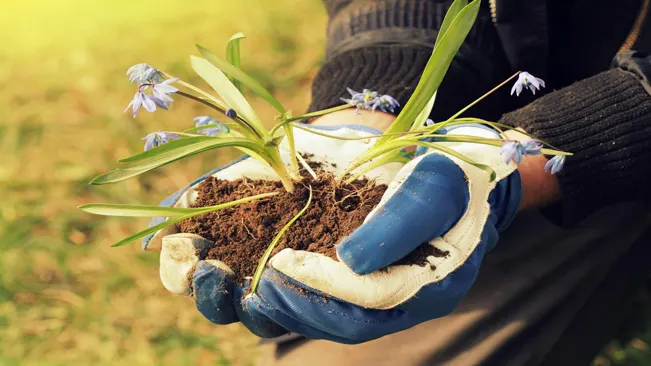
| Benefit | Description |
|---|---|
| Antioxidant Properties | Saffron contains powerful antioxidants like crocin, crocetin, safranal, and kaempferol which help protect your cells against oxidative stress. |
| Mood Enhancement | Saffron is known for its potential to enhance mood and treat depressive symptoms, possibly due to its serotonin reuptake inhibition. |
| Heart Health | The spice may help reduce heart disease risk factors, such as cholesterol levels, thanks to its antioxidant content. |
| Memory Improvement | Saffron is observed to improve memory in some studies, potentially beneficial in treating Alzheimer’s disease and other cognitive impairments. |
| Vision Health | Compounds in saffron might protect against age-related macular degeneration and improve vision in adults with age-related cataracts. |
| Skin Health | Its anti-inflammatory and antimicrobial properties can contribute to skin health, potentially improving acne and skin complexion. |
| Digestive Benefits | Saffron may help in digestion and can be a safe and effective remedy for stomach aches and similar issues. |
| Appetite Control | It is believed to help in weight management by reducing appetite and curbing cravings. |
| Menstrual Symptoms Relief | Saffron can help alleviate menstrual symptoms, including pain and premenstrual syndrome (PMS). |
| Cancer-Fighting Potential | Some studies suggest that saffron components could play a role in cancer prevention and may possess anti-cancer properties. |
Understanding Saffron
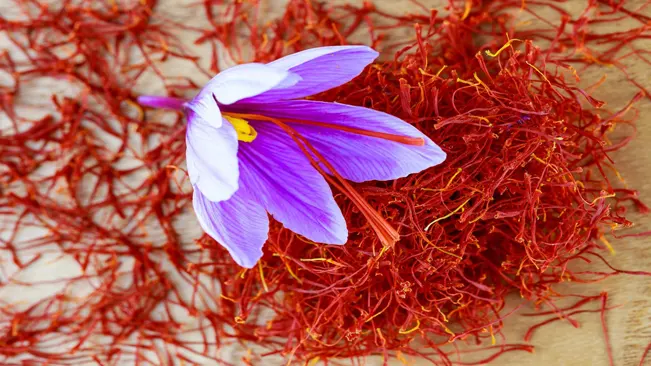
Botanical Background: Expanding on Saffron (Crocus sativus)
- Perennial Nature: As a perennial plant, saffron returns year after year. Each Crocus sativus bulb, technically known as a corm, can produce flowers for several years.
- Flower Characteristics: The saffron flower is notable for its vibrant purple hue, a striking contrast to the red stigmas (threads) that are the source of the spice. Each flower typically has three stigmas.
- Growth Cycle: The plant usually remains dormant during the summer months. As cooler weather arrives in early fall, the saffron crocuses start to bloom. This dormancy period is crucial for the development of the flowers.
- Lifecycle and Propagation: Over time, the original corms produce new daughter corms, which can be separated and replanted to expand your saffron crop. This vegetative propagation ensures a continuous supply of the plant.
Climate and Soil Requirements: Ideal Conditions for Saffron Cultivation
- Mediterranean Climate: Saffron’s ideal climate is key to its successful cultivation. It requires a specific pattern of weather: hot and dry conditions in summer, which mimic its native habitat, followed by a period of cooler and wetter weather in the fall and winter. This climate stimulates the flowering process.
- Soil Composition and Drainage: The soil should not only be rich in organic matter but also possess excellent drainage capabilities. Saffron corms are prone to rot in waterlogged soil, so ensuring good drainage is crucial for healthy growth.
- Soil pH: The slightly acidic to neutral pH range (6 to 8) is optimal. This range supports the necessary nutrient uptake for the plants and helps in the development of strong and healthy corms.
- Microclimate Creation: If you don’t live in a region with a Mediterranean climate, you can create a microclimate or grow saffron in a controlled environment, like a greenhouse. Containers can be used for better control over soil conditions and can be moved to simulate the ideal growing conditions.
Additional Considerations for Growing Saffron
- Spacing and Depth: Proper spacing and depth are key to ensuring that the corms have enough room to grow and are not too shallow to prevent drying out or too deep to hinder growth.
- Harvest Timing: The timing of the harvest is crucial. Stigmas need to be harvested quickly once the flowers open, as they lose their quality rapidly.
- Labor-Intensive Harvesting: Harvesting saffron is labor-intensive, as it requires careful handpicking of the stigmas. This labor contributes significantly to saffron’s status as one of the most expensive spices in the world.
Planting Saffron Crocus Bulbs
Choosing Bulbs
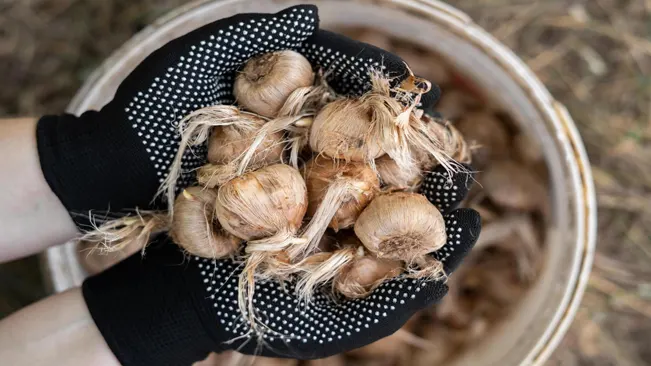
- Quality and Authenticity: It’s crucial to purchase authentic Crocus sativus bulbs. These are specifically used for cultivating saffron and are different from other types of crocus bulbs.
- Size Matters: Look for larger bulbs, as they are generally more mature and likely to produce flowers in the first year.
- Health of Bulbs: Ensure the bulbs are firm and free of mold, rot, or damage. Healthy bulbs are a critical factor for a successful saffron crop.
Planting Time
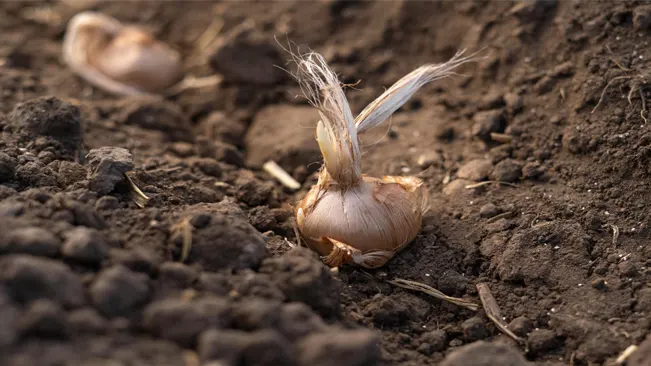
- Why Late Summer to Early Fall?: Planting in this period ensures that the bulbs are settled before winter and ready to bloom in autumn. This timing aligns with the natural growth cycle of the saffron crocus.
- Climate Considerations: The specific month for planting can vary based on your local climate. In cooler areas, earlier planting is beneficial, whereas in warmer regions, you can plant a bit later.
Planting Depth and Spacing
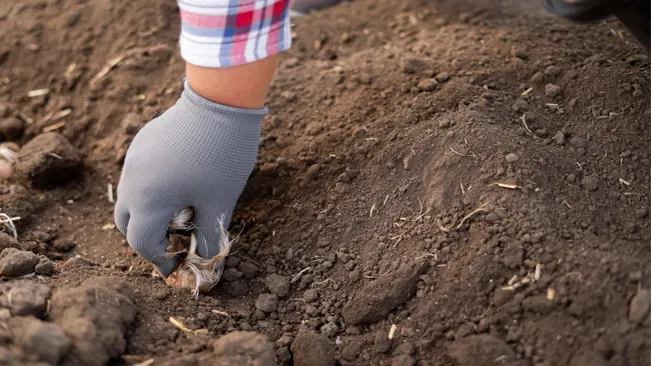
- Depth: Planting bulbs 3 to 4 inches deep helps protect them from temperature fluctuations and surface disturbances. It also ensures that they are anchored well in the soil, which is important for root development.
- Spacing: Keeping bulbs 6 inches apart allows enough space for each plant to grow without competing for nutrients and sunlight. This spacing also facilitates better air circulation, reducing the risk of fungal diseases.
- Orientation: Planting with the pointed end up is essential as this is where the shoot emerges. If planted upside down, the plant might still grow, but it will expend extra energy orienting itself, which can affect health and yield.
Caring for Your Saffron Plants
Watering Saffron Plants
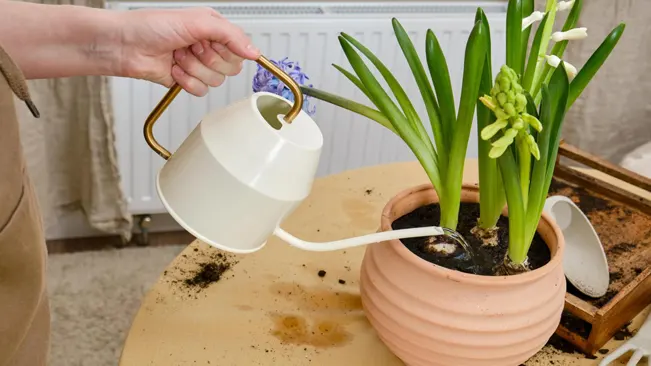
- Frequency and Amount
Saffron plants require consistent moisture during the growing season, particularly when the leaves are growing and during the flowering period. However, it’s crucial to avoid overwatering. The soil should be kept moist, not waterlogged. A general rule is to water the plants once a week, but this can vary depending on your climate and soil type. Sandy soils may require more frequent watering, while clay soils hold moisture longer. - Monitoring Soil Moisture
It’s important to check the soil moisture regularly. You can do this by touching the soil – if the top inch feels dry, it’s time to water. Using mulch around the plants can help retain soil moisture and regulate soil temperature. - Adjusting for Weather and Seasons
Reduce watering after the blooming period as the plant begins to go dormant. Over the winter, saffron corms require a dry period; too much moisture during dormancy can lead to rot.
Fertilizing Saffron Plants
- Type of Fertilizer:
- A balanced, all-purpose fertilizer is suitable for saffron. Look for a fertilizer labeled as 10-10-10 or 20-20-20, which indicates an equal ratio of nitrogen, phosphorus, and potassium.
- Application:
- Apply fertilizer at the start of the growing season, which is usually spring when the leaves start to emerge. Follow the instructions on the fertilizer package for the correct amount.
- Avoiding Over-Fertilization:
- Excessive fertilization can damage saffron plants. Signs of over-fertilization include yellowing or wilting leaves and stunted growth. In extreme cases, it can cause root burn or even kill the plant.
Weeding
Regular Weeding
Weeds compete with saffron plants for nutrients, water, and sunlight. Regular weeding is essential to ensure your saffron plants don’t get overshadowed or outcompeted.
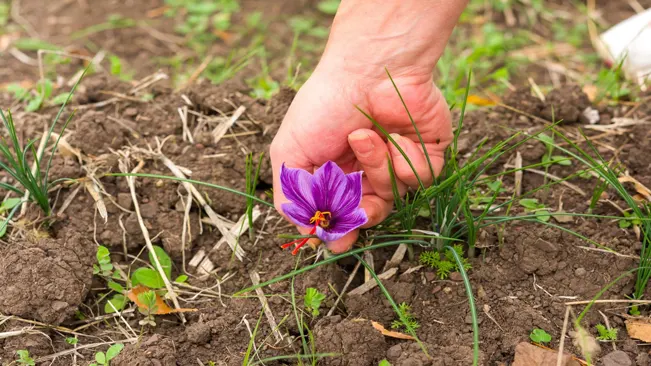
Mulching
Applying a layer of organic mulch can help suppress weeds. This also adds organic matter to the soil as it decomposes and improves soil health.
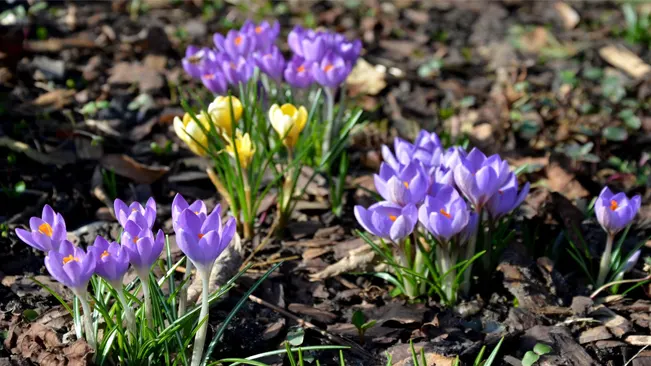
- Gentle Weeding Techniques
Be gentle when weeding around saffron plants to avoid disturbing the roots. Hand-pulling or using a small hoe is often the best approach.
Harvesting and Drying Saffron
Harvesting Saffron Stigmas
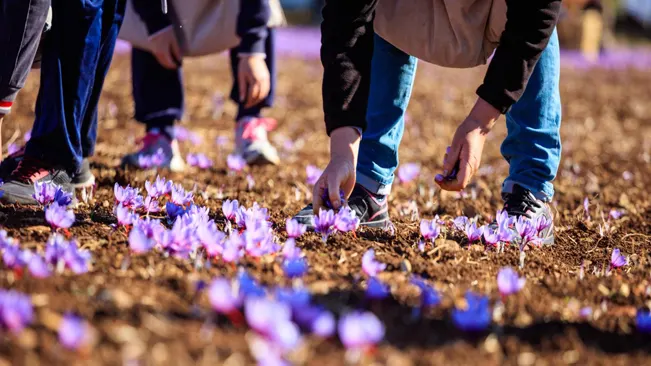
- Timing is Key: The ideal time for harvesting saffron stigmas is in the morning, just after the flowers have opened. This is typically in the autumn, about 6-8 weeks after planting. The timing is crucial because the stigmas are most fragrant and potent at this stage.
- Identifying Ready Flowers: Look for flowers that are fully open. The saffron stigmas are the three long, red threads in the center of the flower. They stand out clearly against the purple petals.
- Method of Harvesting: Use a pair of fine tweezers to gently pluck the red stigmas from the flower. It’s important to be delicate to avoid damaging the stigmas. Each flower will typically have three stigmas.
- Efficiency and Care: Since each flower produces only a small amount of saffron, efficiency in harvesting is important. However, careful handling is paramount to maintain the integrity of the stigmas.
- Volume of Harvest: Be prepared for the labor-intensive nature of this process. It takes approximately 150 flowers to yield just one gram of dried saffron.
Drying Saffron Stigmas

- Immediate Drying: After harvesting, it’s crucial to dry the stigmas as soon as possible to preserve their flavor and prevent spoilage.
- Drying Methods:
- Using a Dehydrator: This is the most efficient method. Set the dehydrator at a low temperature (around 30-35°C or 86-95°F) and dry for a few hours until the stigmas are brittle to the touch.
- Natural Drying: Place the stigmas in a warm, dry, and well-ventilated area, away from direct sunlight. This could be an airy room or near a window. Laying the stigmas on a piece of paper or a fine mesh screen helps.
- Duration of Drying: The drying process typically takes a few days, depending on the method and environmental conditions. The stigmas are properly dried when they are brittle and break when bent.
- Checking for Quality: Properly dried saffron should retain its red color and have a strong aroma. If the stigmas lose their color or smell musty, they may have been over-dried or exposed to too much moisture.
- Storage Post-Drying: Once dried, store the saffron stigmas in an airtight container, away from light and moisture. Properly stored, saffron can retain its quality for several years.
Storage and Usage
Storing Saffron
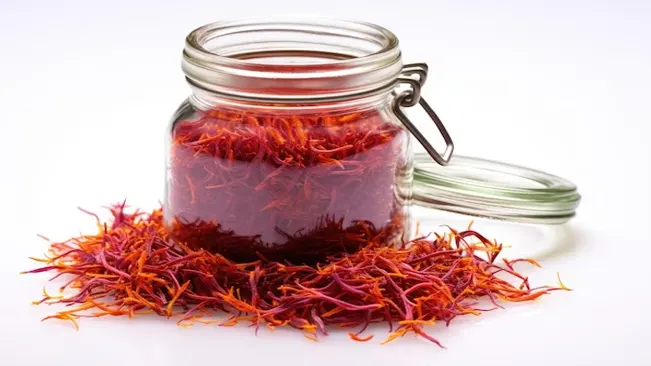
Saffron, being one of the most expensive spices by weight, requires proper storage to maintain its distinctive aroma, flavor, and color:
- Airtight Container: It’s crucial to store saffron in an airtight container. Exposure to air can lead to the loss of its aromatic compounds.
- Cool and Dark Place: Saffron should be stored away from light and heat. Light can degrade the quality of saffron, and heat can cause it to lose its potency. A cupboard or a pantry is usually a good spot.
- Avoid Moisture: Any moisture can lead to mold growth and spoil the saffron. Ensure the saffron is completely dry before storing.
- Longevity: When stored properly, saffron can retain its quality for several years. However, it’s generally recommended to use it within 1-2 years for the best flavor.
Using Saffron
Saffron is renowned for its unique flavor and is used sparingly due to its high cost:
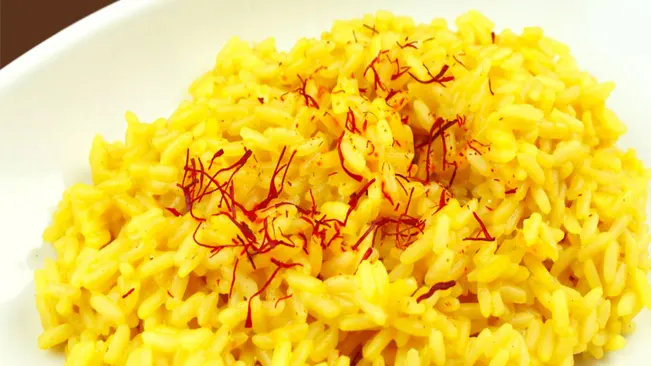
- Quantity: A little saffron goes a long way. Often just a few threads are enough to impart flavor and color to an entire dish.
- Preparation: To maximize its flavor, saffron threads can be gently toasted or soaked in a liquid (like warm water, broth, or milk) for about 10-15 minutes before being added to the dish.
- Culinary Uses: Saffron is versatile in the kitchen. It’s famous in dishes like Spanish paella, Italian risotto alla Milanese, and Indian biryanis. It also finds its way into desserts, such as saffron-infused ice creams or pastries.
- Flavor Profile: Saffron adds a complex taste to dishes, often described as floral, slightly sweet, and earthy. It’s a subtle flavor that doesn’t overpower but adds depth to a dish.
- Color: Saffron is also valued for its natural golden-yellow hue, which it imparts to dishes. This coloring is especially sought after in rice dishes.
Common Challenges and Solutions
Pests and Diseases
Rodents and Birds
- Problem: Saffron crocus corms and flowers can be attractive to rodents like mice and voles, as well as birds, which can dig up and eat the corms or damage the flowers.
- Solution: To protect against rodents, consider planting the corms in wire cages buried in the soil. For birds, using netting over the plants can be effective. Regularly inspecting the area for signs of pest activity and taking prompt action can also help mitigate these issues.
Fungal Diseases
- Problem: Saffron is susceptible to various fungal diseases, such as corm rot (caused by fungi like Fusarium spp.) and rust. These diseases can severely affect plant health and yield.
- Solution: Good cultural practices are key. Ensure proper drainage to avoid waterlogging, which promotes fungal growth. Crop rotation and removing plant debris can also help prevent fungal diseases. In case of infection, using appropriate fungicides as per local agricultural guidelines is crucial. Always follow the manufacturer’s instructions for safe and effective use.
Climate Concerns
Cold Temperatures
- Problem: Saffron crocuses are not frost-tolerant and can be damaged by very cold temperatures.
- Solution: In regions with harsh winters, growing saffron in containers is an excellent alternative. Containers allow for easy mobility, so you can move the plants indoors or to a protected area during extreme cold. Ensure the indoor environment has enough light and is well-ventilated.
Inadequate Sunlight
- Problem: Saffron requires a good amount of sunlight to thrive. In regions with limited sunlight, especially during the growing season, this can be a challenge.
- Solution: Positioning saffron containers in the sunniest part of your garden or using grow lights when growing indoors can help provide the necessary light levels.
Varying Moisture Levels
- Problem: In regions with heavy rainfall, there’s a risk of waterlogging, while in arid areas, maintaining adequate moisture can be challenging.
- Solution: For excessive rain, ensure your planting site or containers have excellent drainage. Raised beds can also be beneficial. In dry areas, regular watering is essential, but be careful not to over-water.
Conclusion
Growing saffron can be a deeply satisfying experience, particularly given its value and the flavor it adds to culinary dishes. By following these guidelines and providing attentive care, gardeners can successfully cultivate this precious spice in their own backyards.
FAQs (Frequently Asked Questions)
- What is the best time to plant saffron bulbs?
Saffron bulbs should be planted in late summer to early fall. This timing allows for the crocuses to bloom in the autumn. - What type of soil is ideal for growing saffron?
Saffron prefers well-draining soil rich in organic matter, with a pH between 6 and 8. Avoid waterlogged or overly wet soils. - How deep should I plant saffron bulbs?
Plant the bulbs about 3 to 4 inches deep, with the pointed end facing upwards. - How much space is needed between saffron plants?
Space the bulbs about 6 inches apart to allow adequate room for growth. - How much sunlight does saffron need?
Saffron requires full sunlight. Choose a planting site that receives several hours of direct sunlight daily. - When and how is saffron harvested?
Harvest saffron in the morning soon after the flowers open, usually in autumn. Carefully pluck the red stigmas (threads) using tweezers. - How should I water my saffron plants?
Water the plants regularly during the growing season, ensuring the soil is moist but not waterlogged. Reduce watering after the blooming period. - Does saffron need fertilization?
Yes, use a balanced fertilizer at the start of the growing season. Avoid over-fertilizing to prevent harm to the plants. - Can I grow saffron in a colder climate?
In colder regions, it’s advisable to grow saffron in containers that can be moved indoors during harsh winter conditions. - How long does it take for a saffron plant to produce flowers?
Saffron crocuses typically flower in their first autumn after planting. However, full spice production may take 1-2 years to establish.

Kristine Moore
Forestry AuthorI'm Kristine Moore, a seasoned garden landscaping professional with over 30 years of experience. My extensive career has been dedicated to transforming outdoor spaces into stunning, sustainable landscapes. With a deep understanding of horticulture, design principles, and environmental stewardship, I have become a respected figure in the field, known for creating harmonious, visually appealing, and eco-friendly gardens. My commitment to excellence and continuous learning in landscaping trends and techniques has solidified my reputation as an expert in garden design and implementation.

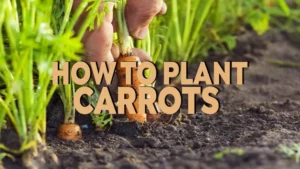

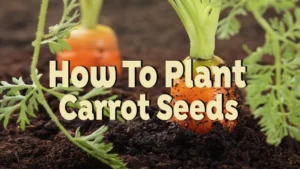
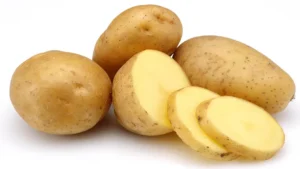

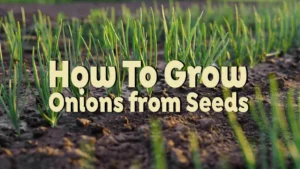

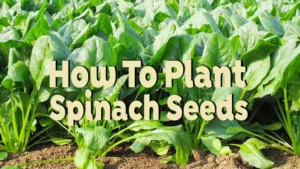
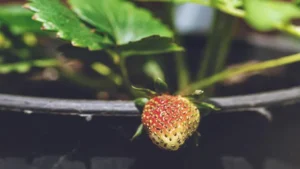

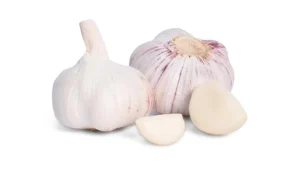

Leave your comment